The Hummingbird
Most species are between 7.5 and 13 cm in size. You would almost think it is an out-sized bumblebee! Hummingbirds (Trochilidae) are the smallest birds in the world. They are a family of birds of the order swift-like. The family includes more than 300 species. Most species are found in South America. It is so much fun to spot hummingbirds, the smallest bird in the world! Rapidly flying, their wings are more quivering than fluttering, so small and so fast and agile. Read all about this extraordinary bird here.
Hummingbirds in Costa Rica
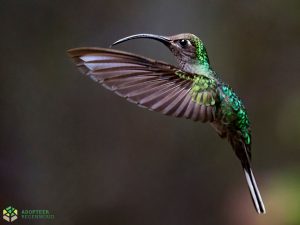
OLYMPUS DIGITAL CAMERA
Hummingbirds descend on the nectar of flowers and therefore feel at home in Costa Rican flora. Hummingbirds can be spotted mainly in Uvita, Carara National Park, the Monteverde cloud forest, the cloud forests near San Gerardo de Dota and the valley of Turrialba. But actually, you will encounter them throughout Costa Rica. Costa Rica is home to some 52 different species of hummingbirds. Because they are so extremely fast, special drinking cups with honey water have been hung in various places in parks or nature reserves to lure the hummingbirds there. These feeders are ideal for getting a good photo. Some common hummingbirds in Costa Rica include: the ruby-throated hummingbird, black-bellied hummingbird, sparkling hummingbird, volcano hummingbird, white-throated mountain jay, red-tailed hummingbird, blue-throated hummingbird, green-throated mountain jay, and the magenta throated woodstar.
Special bird
Like a little helicopter, a hummingbird soars through the air. As it does so, it makes a distinctive humming or humming sound. Hence the name “hummingbird” in English. The sound the wings make sounds almost like a piano or violin. They can make different tones. A hummingbird makes this sound in the same way an insect makes the humming sound: namely, by flapping its tiny wings up and down at lightning speed. The bird does this up to 40 times per second. This creates vibrations in the air. And that’s how you hear the buzzing sound. They are called the helicopters among birds because they can hover while flying; they can even fly straight up or down!
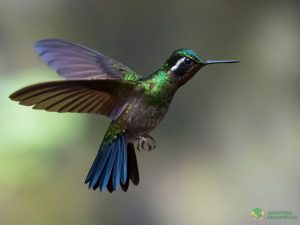
OLYMPUS DIGITAL CAMERA
Speed
A male hummingbird flies fastest during a dive. He then flies as far as 385 times his own body length in one second. That’s as much as 100 kilometers per hour. So a hummingbird can almost overtake you on the highway. During that top speed, it flaps its wings up and down 15 to 80 times per second.
Pointed beak
The hummingbird uses its beak to suck nectar and pollen from flowers. Different species of hummingbirds have different beaks. Some have beaks almost as long as the entire body, about 10 cm long! For example, the sword hummingbird. But others have a beak that is strongly curved downward or one that is curved upward only at the tip. Each beak is specialized on a particular flower shape, so there is no competition between hummingbird species.
Colors
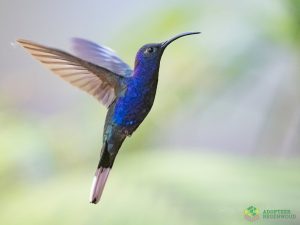
OLYMPUS DIGITAL CAMERA
The male hummingbird is variegated, usually metallic green in color, with a brilliant red, blue or emerald green throat color. The female is more inconspicuously colored. Hummingbirds can show and hide their bright colors when necessary.
Large differences in weight occur between species. The smallest, the Bee Hummingbird is only 5 cm tall and weighs 1.8 grams. The hummingbird most common in North America, the Ruby-throated Hummingbird, weighs about 3 grams and measures 7.6 cm. Hummingbirds can live up to 15 years and return to the same place every year. During the colder months, the birds migrate to warmer, more southern regions.
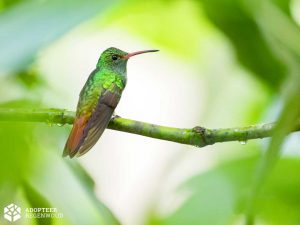 Spiritual significance
Spiritual significance
The hummingbird symbolizes the joy of life and the lightness of being. The little bird flies from flower to flower and is always actively seeking the sweetest nectar. It teaches us to seek the beauty in each day, to enjoy in the Here and Now and to look for that which makes you happy and happy.
Hummingbirds in the reserve of Adopt Rainforest
Costa Rica is home to the reserve of the Adopt Rainforest Foundation. This reserve is home to 16 different species of hummingbirds. This is an unprecedented number when you consider that there are 52 species of hummingbirds in all of Costa Rica. A clear indication of how high biodiversity is in this foundation’s rainforest. Would you also like to contribute to the protection of this special nature reserve? Then adopt a piece of rainforest here.
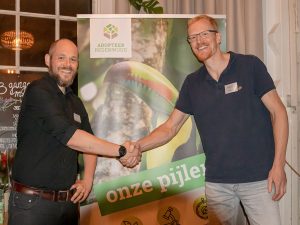 on with Utrecht University. The foundation was ready for a new step to professionalize the research project and Utrecht University was looking for a stable and reliable partner in Central America to conduct solid research in the rainforest. So for both parties this is a wonderful collaboration! Because of this we will make a big step in professionalizing our current research on biodiversity in our reserve. Together with the visiting students we will focus on scientific research in which the diversity and development of nature in our reserve, with an emphasis on flora, is central.
on with Utrecht University. The foundation was ready for a new step to professionalize the research project and Utrecht University was looking for a stable and reliable partner in Central America to conduct solid research in the rainforest. So for both parties this is a wonderful collaboration! Because of this we will make a big step in professionalizing our current research on biodiversity in our reserve. Together with the visiting students we will focus on scientific research in which the diversity and development of nature in our reserve, with an emphasis on flora, is central.